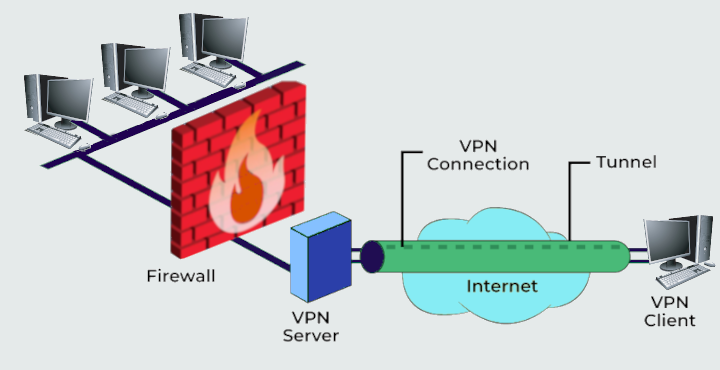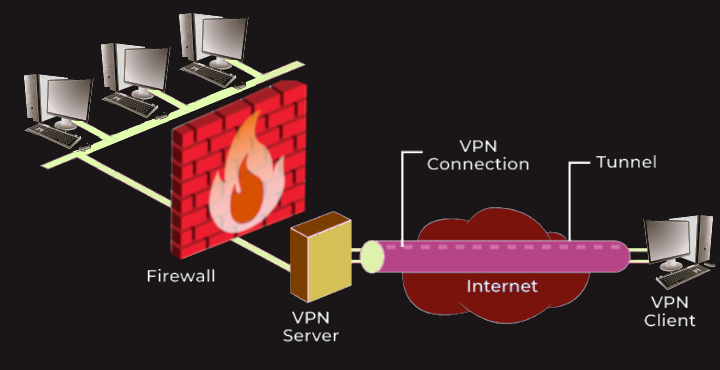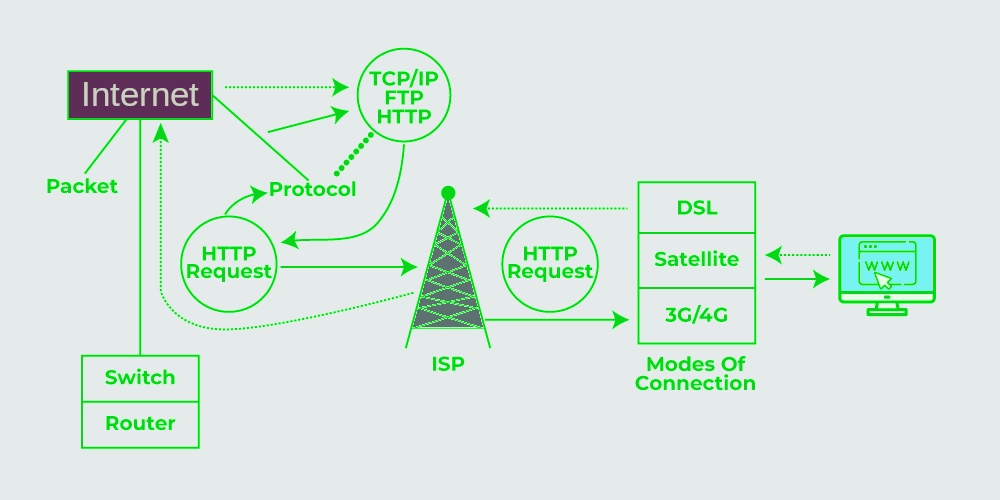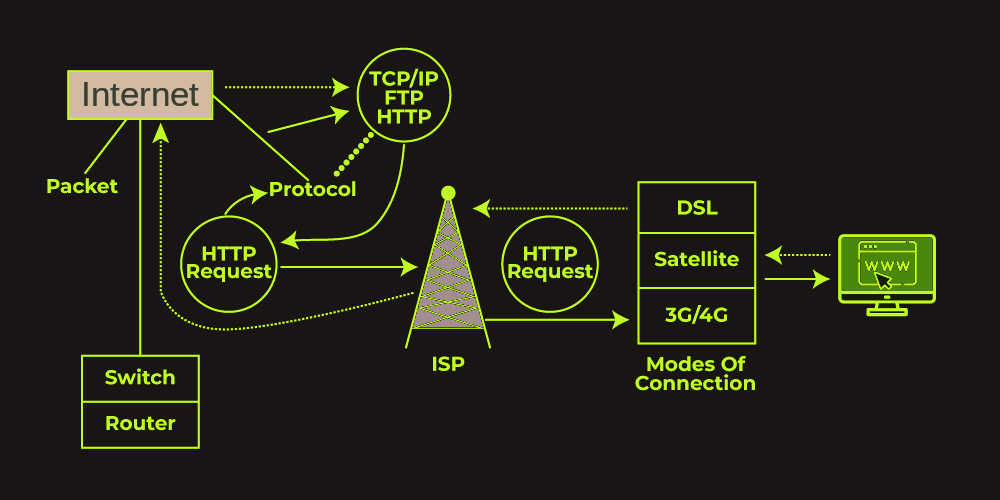Intranet
Most organizations have their own individual servers, routers, and switches that connect all computers and devices in the organization together, which allows all employees to access shared drives, printers, and common applications like HR and financial systems. Depending on the size of the organization, an intranet could be anywhere between just a slightly more extensive LAN, or a mini-internet that spans across many countries. An intranet also allows a user to log in to any computer on the network, and access their personal network drive and it is separated from the Internet by a firewall for added security.
VPN is a virtual private network (VPN), it allows someone with the right login credentials to access their intranet from outside the intranet, through the Internet. A VPN essentially establishes a secure line to the intranet’s network, making it seem like the client is on the organization’s premises, connected directly to the intranet. 
 Both a VPN and a firewall are powerful network security tools. A VPN is a software tool that hides someone's IP address while accessing the Internet. It also encrypts someone's data and makes it safe from cyberattacks. On the other hand, firewalls keep out unauthorized traffic and prevent malware from entering person's computer. They are typically pre-installed in Windows computers, allowing users to set up rules for limiting access to specific websites or programs. In addition, firewalls can block particular ports that malicious entities can use to gain unauthorized access to person's device. They can also alert someone if suspicious activity is detected on the network. Some firewalls even offer the option to block certain web pages or websites entirely if they are identified as potentially harmful.
Both a VPN and a firewall are powerful network security tools. A VPN is a software tool that hides someone's IP address while accessing the Internet. It also encrypts someone's data and makes it safe from cyberattacks. On the other hand, firewalls keep out unauthorized traffic and prevent malware from entering person's computer. They are typically pre-installed in Windows computers, allowing users to set up rules for limiting access to specific websites or programs. In addition, firewalls can block particular ports that malicious entities can use to gain unauthorized access to person's device. They can also alert someone if suspicious activity is detected on the network. Some firewalls even offer the option to block certain web pages or websites entirely if they are identified as potentially harmful.
The Layers of the Internet
The OSI model is derived from a proposal that was developed by the International Standards Organization. The OSI model was designed to aid manufacturers to create technology in line with universal standards that set out the basics of how devices would communicate with each other. The OSI model acts as a roadmap of what is happening within a network and helps to see how information is transferred across a network. It is a conceptual, theoretical model developed in the 1980s by an international group of engineers and scientists working under the auspices of the International Organization for Standardization (ISO). The model standardized a layered approach to telecommunications, where each layer provides a certain level of abstraction and functionality. Each layer also contains some encapsulated data to be opened and used by the layer directly above it (7-layers). 
 The older, TCP/IP model was originally funded and developed by the US Department of Defense in the 1970s, and is also known as the Internet protocol suite. This practical model focused on establishing protocols for communication, the main ones being the Internet Protocol (IP) and the Transmission Control Protocol (TCP), after which the model was later named, and the model actually emphasized architectural principles more than layering (4-layers).
The older, TCP/IP model was originally funded and developed by the US Department of Defense in the 1970s, and is also known as the Internet protocol suite. This practical model focused on establishing protocols for communication, the main ones being the Internet Protocol (IP) and the Transmission Control Protocol (TCP), after which the model was later named, and the model actually emphasized architectural principles more than layering (4-layers).
How does the Internet work?
Computers connect to each other and to the Internet via wires, cables, radio waves, and other types of networking infrastructure. All data sent over the Internet is translated into pulses of light or electricity, also called "bits", and then interpreted by the receiving computer. The wires, cables, and radio waves conduct these bits at the speed of light. The more bits that can pass over these wires and cables at once, the faster the Internet works.
There is no control center for the Internet. Instead, it is a distributed networking system, meaning it is not dependent on any individual machine. Any computer or hardware that can send and receive data in the correct fashion (e.g. using the correct networking protocols) can be part of the Internet.
There are two main concepts that are fundamental to the way the Internet functions: packets and protocols.
In networking, a packet is a small segment of a larger message. Each packet contains both data and information about that data. The information about the packet's contents is known as the "header", and it goes at the front of the packet so that the receiving machine knows what to do with the packet. When data gets sent over the Internet, it is first broken up into smaller packets, which are then translated into bits. The packets get routed to their destination by various networking devices such as routers and switches. When the packets arrive at their destination, the receiving device reassembles the packets in order and can then use or display the data. Packets are sent across the Internet using a technique called packet switching. Intermediary routers and switches are able to process packets independently from each other, without accounting for their source or destination. This is by design so that no single connection dominates the network. If data was sent between computers all at once with no packet switching, a connection between two computers could occupy multiple cables, routers, and switches for minutes at a time. Essentially, only two people would be able to use the Internet at a time — instead of an almost unlimited number of people, as is the case in reality.
Connecting two computers, both of which may use different hardware and run different software, is one of the main challenges that the creators of the Internet had to solve. It requires the use of communications techniques that are understandable by all connected computers. This problem is solved with standardized protocols. In networking, a protocol is a standardized way of doing certain actions and formatting data so that two or more devices are able to communicate with and understand each other. There are protocols for sending packets between devices on the same network (Ethernet), for sending packets from network to network (IP), for ensuring those packets successfully arrive in order (TCP), and for formatting data for websites and applications (HTTP). In addition to these foundational protocols, there are also protocols for routing, testing, and encryption. And there are alternatives to the protocols listed above for different types of content — for instance, streaming video often uses UDP instead of TCP.
Routers forward packets to different computer networks based on their destination. Routers are like the traffic cops of the Internet, making sure that Internet traffic goes to the right networks.
Switches connect devices that share a single network. They use packet switching to forward packets to the correct devices. They also receive outbound packets from those devices and pass them along to the right destination.
Web servers are specialized high-powered computers that store and serve content (webpages, images, videos) to users, in addition to hosting applications and databases. Servers also respond to DNS queries and perform other important tasks to keep the Internet up and running. Most servers are kept in large data centers, which are located throughout the world.
In order for you to see this page, it was sent over the Internet piece by piece in the form of several thousand, or more, data packets. These packets traveled over cables and radio waves and through routers and switches from ISP's web server to your computer or device. Your computer or smartphone received those packets and passed them to your device's browser, and your browser interpreted the data within the packets in order to display the text and images you are seeing now. 
 The specific steps involved in this process are:
The specific steps involved in this process are:
1. DNS query: When your browser started to load this webpage, it likely first made a DNS query to find out the uciradiuzivaj website's IP address.
2. TCP handshake: Your browser opened a connection with that IP address.
3. TLS handshake: Your browser also set up encryption between an uciradiuzivaj web server and your device so that attackers cannot read the data packets that travel between those two endpoints.
4. HTTP request: Your browser requested the content that appears on this webpage.
5. HTTP response: uciradiuzivaj's server transmitted the content in the form of HTML, CSS, and JavaScript code, broken up into a series of data packets. Once your device received the packets and verified it had received all of them, your browser interpreted the HTML, CSS, and JavaScript code contained in the packets to render this specific webpage about elektrotehnika topic. The whole process took only a second or two.
The creation of the Internet was an incredible achievement that involved the collective efforts of thousands of individuals and organizations. The fact that the Internet functions today at a far bigger scale than its founders anticipated is a testament to their work.







